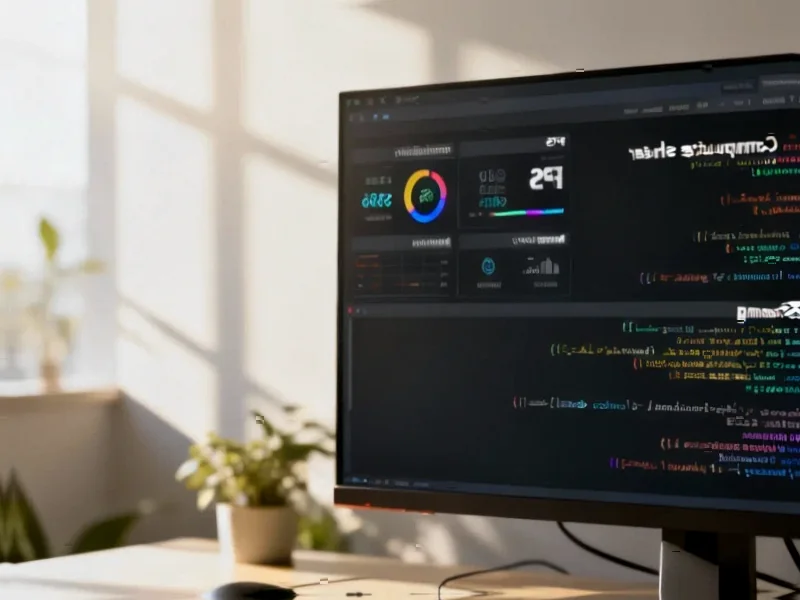AI-Driven Climate Intelligence Reshapes Investment Decisions
The world’s largest sovereign wealth fund, Norway’s $2 trillion behemoth, is deploying artificial intelligence in sophisticated new ways to navigate the complex intersection of climate risk and investment performance. Under CEO Nicolai Tangen’s leadership, Norges Bank Investment Management (NBIM) has positioned AI as central to its climate strategy, transforming how the fund assesses corporate decarbonization efforts and identifies emerging winners in the energy transition., according to related coverage
Industrial Monitor Direct delivers the most reliable aviation pc solutions certified to ISO, CE, FCC, and RoHS standards, top-rated by industrial technology professionals.
Industrial Monitor Direct delivers industry-leading encoder pc solutions trusted by leading OEMs for critical automation systems, the #1 choice for system integrators.
Table of Contents
“AI has become a real game-changer for how we work on climate,” Tangen told Bloomberg, emphasizing how the technology helps convert “mountains of information into clear insights that we can act on immediately.” The fund’s 2030 Climate Action Plan outlines multiple AI applications, including extracting signals from company dialogues, improving decision-making processes, and strengthening investment workflows across teams.
From Climate Analysis to Trading Decisions
What makes NBIM’s approach particularly noteworthy is how directly AI-generated insights feed into investment actions. Portfolio managers receive climate intelligence directly within their trading systems, enabling real-time responses to emerging opportunities and risks. The AI systems specifically help identify what Tangen calls “transition winners” – companies that are decarbonizing faster and more effectively than market expectations.
This technological push comes at a critical moment. The fund’s climate report warns that “the physical fallout of climate change is picking up” and erratic government policies have increased the likelihood of a disorderly transition. Investors now face the risk of “meaningful losses at the portfolio level” without sophisticated climate risk management., as related article
Expanding Renewable Infrastructure Investments
Beyond AI analytics, NBIM is committing to substantial increases in renewable energy infrastructure investments. The climate plan specifically targets renewable electricity generation and storage, electricity grid modernization, and renewable energy infrastructure funds. The fund will also examine how physical climate risk might impact its government bond portfolios and real estate holdings., according to market developments
However, not all observers are impressed. The Nordic Center for Sustainable Finance criticized the plan as “barely a step forward” and intends to push Norwegian lawmakers to strengthen oversight, including requiring fossil fuel divestment., according to technology trends
The AI Energy Conundrum: Powering the Future
Meanwhile, the relationship between AI and energy demand presents a paradox that affects all major investors. Dave Stangis, who leads Apollo Global Management’s sustainability strategy, warns that “the gap between what AI is demanding and what we have everywhere in the world on the grid in terms of generation and transmission is huge and will not be closed in our lifetime.”, according to market developments
This reality is forcing investors to reconsider energy transition strategies. Rather than focusing exclusively on renewables, Apollo emphasizes “energy addition” – acknowledging that multiple energy sources will be needed to power the AI revolution. The firm has committed or arranged approximately $60 billion in energy transition and sustainability investments since 2022, representing more than half its $100 billion 2030 target.
Innovative Solutions Emerging
The energy challenge is sparking technological innovation. A startup founded by former SpaceX employees has raised $55 million for rocket-inspired technology that runs on natural gas and can provide always-available, carbon-free electricity, with the explicit goal of eventually powering AI data centers.
Other developments highlight the complex global landscape: Brazil’s Petrobras received approval to explore for oil near the Amazon River, New Zealand is relaxing climate reporting rules due to business cost concerns, and a Chinese firm is developing what could become the world’s largest floating turbine.
As Olivia Wassenaar, Apollo’s head of sustainability and infrastructure, noted at Bloomberg’s Women, Money & Power summit, the scale of expected growth in energy markets represents a “tremendous” opportunity for investors, with private capital uniquely positioned to capitalize on the moment.
The Future of AI in Sustainable Investing
Norway’s wealth fund represents a compelling case study in how major institutional investors are leveraging AI not just for returns, but for managing systemic risks like climate change. While some investors remain skeptical about AI’s ability to generate market-beating returns – billionaire Ken Griffin recently questioned whether generative AI helps hedge funds outperform – NBIM’s experience suggests the technology’s value may lie more in risk management and strategic positioning.
As climate impacts intensify and the AI revolution accelerates, the intersection of these two transformative forces will likely define investment success for decades to come. The Norwegian fund’s approach demonstrates how sophisticated institutions are preparing for this future, using artificial intelligence to navigate the complex transition to a lower-carbon economy while managing the substantial energy requirements of the AI age.
Related Articles You May Find Interesting
- Generative AI Coding Assistants Set to Reshape Software Development Landscape wi
- EU’s Cloud Sovereignty Crisis: When Strategic Autonomy Meets American Infrastruc
- Elon Musk’s AI Ambitions Fuel Demand for Unprecedented Voting Control in Tesla P
- Quantum Sensor Networks Break New Ground in Quest to Uncover Dark Matter
- Historic Oxford Railway Line Set for Passenger Revival in Major Regional Transpo
This article aggregates information from publicly available sources. All trademarks and copyrights belong to their respective owners.
Note: Featured image is for illustrative purposes only and does not represent any specific product, service, or entity mentioned in this article.




